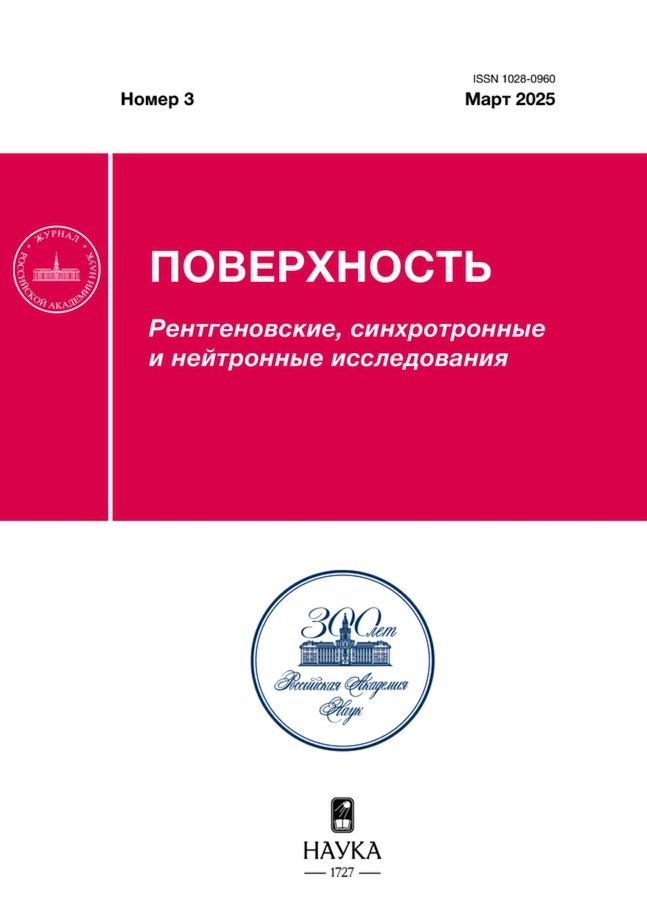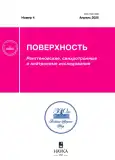Влияние облучения мощным ионным пучком на атмосферное окисление поликристаллического магния
- Авторы: Панова Т.В.1, Ковивчак В.С.1
-
Учреждения:
- Омский государственный университет им. Ф.М. Достоевского
- Выпуск: № 4 (2025)
- Страницы: 49-55
- Раздел: Статьи
- URL: https://gynecology.orscience.ru/1028-0960/article/view/689152
- DOI: https://doi.org/10.31857/S1028096025040077
- EDN: https://elibrary.ru/FBZSGV
- ID: 689152
Цитировать
Полный текст
Аннотация
Проведены исследования влияния воздействия мощного ионного пучка в течение нескольких десятков наносекунд на атмосферное окисление поликристаллического магния. Обнаружено уменьшение количества оксидной фазы магния при возрастании плотности тока пучка, что, вероятно, связано с усилением процессов газодинамического разлета поверхности. Последующая выдержка необлученных и облученных мощным ионным пучком образцов при температуре 240°С на воздухе привела к замедлению роста оксидной фазы в облученных образцах. Наибольший эффект наблюдали в образцах, облученных пучком с плотностью тока 150 А/см2. Обсуждена роль химических процессов, механических напряжений и структурных изменений, протекающих в модифицированной пучком зоне и влияющих на процесс окисления. Наблюдаемые немонотонные зависимости отношений концентраций кислорода и углерода к магнию от времени нагрева образцов объяснены образованием не только оксида, но и, вероятно, гидроксида и карбоната магния. Показано, что на эффект повышения сопротивления окислению магния, облученного мощным ионным пучком, может также оказывать влияние повышение концентрации углерода при его внедрении в поверхностный слой материала.
Ключевые слова
Полный текст
Об авторах
Т. В. Панова
Омский государственный университет им. Ф.М. Достоевского
Автор, ответственный за переписку.
Email: panovatv@omsu.ru
Россия, Омск
В. С. Ковивчак
Омский государственный университет им. Ф.М. Достоевского
Email: panovatv@omsu.ru
Россия, Омск
Список литературы
- Jayasathyakawin S., Ravichandran M., Baskar N., Chairman C.A., Balasundaram R. // Materials Today: Proc. 2020. V. 27. P. 909. https://www.doi.org/10.1016/j.matpr.2020.01.255
- Chen J., Tan L., Yu X., Etim I.P., Ibrahim M., Yang K. // J. Mech. Behavior Biomed. Mater. 2018. V. 87. P. 68. https://www.doi.org/10.1016/j.jmbbm.2018.07.022
- Chen J., Xu Y., Kolawole S.K., Wang J., Su X., Tan L., Yang K. // Materials. 2022. V. 15. P. 5031. https://www.doi.org/10.3390/ma15145031
- Wei L., Gao Z. // RSC Adv. 2023. V. 13. Р. 8427. https://www.doi.org/10.1039/D2RA07829E
- Atrens A., Chen X., Shi Z. // Corros. Mater. Degrad. 2022. V. 3. P. 566. https://www.doi.org/10.3390/cmd3040031
- Галкин Н.Г., Ваванова С.В., Галкин К.Н., Баталов Р.И., Баязитов Р.М., Нуждин В.И. // Журнал технической физики. 2013. Т. 83. Вып. 1. С. 99.
- Nene S.S., Kashyap B.P., Prabhu N., Estrin Y., Al-Samman T. // J. Mater. Sci. 2015. V. 50. P. 3041. https://www.doi.org/10.1007/s10853-015-8846-y
- Лебедев В.А., Седых В.И. Металлургия магния. Екатеринбург: УГТУ-УПИ, 2010. 174 с.
- Bahmani A., Arthanari S., Shin K.S. // J. Magnesium Alloys. 2020. V. 8. P. 134. https://www.doi.org/10.1016/j.jma.2019.12.001
- Козлов И.А., Каримова С.А. // Авиационные материалы и технологии. 2014. № 2. С. 15. https://www.doi.org/10.18577/2071-9140-2014-0-2-15-20
- Yao W., Wu L., Huang G., Jiang B., Atrens A., Pan F. // J. Mater. Sci. Technol. 2020. V. 52. P. 100. https://www.doi.org/10.1016/j.jmst.2020.02.055
- Синявский В.С. // Технология легких сплавов. 2011. № 2. С. 77.
- Liu C., Liang J., Zhou J., Wang L., Li Q. // Appl. Surf. Sci. 2015. V. 343. P. 133. https://www.doi.org/10.1016/j.apsusc.2015.03.067
- Yu B., Dai J., Ruan Q., Liu Z., Chu P.K. // Coatings. 2020. V. 10. P. 734. https://www.doi.org/10.3390/coatings10080734
- Liu Y.R., Zhang K.M., Zou J.X., Liu D.K., Zhang T.C. // J. Alloy. Compd. 2018. V. 741. P. 65. https://www.doi.org/10.1016/j.jallcom.2017.12.227
- Kovivchak V.S., Nesov S.N., Panova T.V, Korusenko P.M. // Appl. Surf. Sci. 2024. V. 654. P. 159491. https://www.doi.org/10.1016/j.apsusc.2024.159491
- Panova T.V., Kovivchak V.S. // J. Surf. Invest.: X-ray, Synchrotron Neutron Tech. 2022. V. 16. № 2. P. 347. https://www.doi.org/10.1134/S102745102202032X
- SRIM & TRIM (2013) http://www.srim.org/
- Романов В.В.Коррозия магния. М.: Изд-во Акад. наук СССР, 1961. 68 с.
- Модифицирование и легирование поверхности лазерными, ионными и электронными пучками. Пер. с англ. / Ред. Поут Дж.М., Фоти Г. и др. М.: Машиностроение, 1987. 423 с.
- Грибков В.А., Григорьев В.И., Калин Б.А., Якушин В.Л. Перспективные радиационно-пучковые технологии обработки материалов. М.: Круглый год, 2001. 528 с.
Дополнительные файлы













